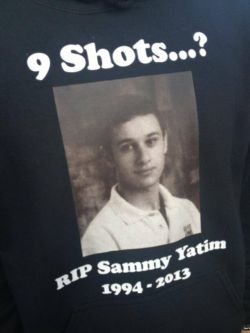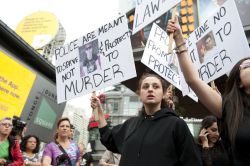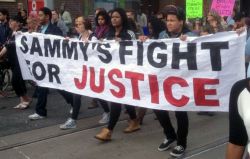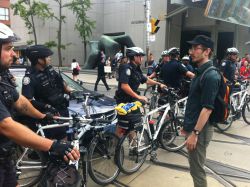Toronto Media Co-op
Local Independent News
The Struggle Against Police Brutality — The Police Execution of Sammy Yatim
This article was originally published by Fightback (www.marxist.ca).
The killing of Sammy Yatim by the Toronto Police Services has created an outpouring of grief, anger and indignity at police conduct. Within just days of the killing over one thousands gathered in downtown Toronto to protest the police action. This protest included the family and friends of Yatim, but also many who were attending their first protest. Many of those who attended identified their own experiences of harassment and violence at the hands of police with the killing of Yatim.
This incident, not unlike dozens of others that have occurred in the past, has given expression to this accumulated anger. The graphic event was captured on video (Watch here) and has been viewed more than one million times on various websites. This has certainly contributed to the public response. One cannot view the film, and the nine rounds that are slowly fired into Yatim, six of which are fired after Yatim had clearly been shot and had fallen to the ground, without shuddering. What you are witnessing is an executioner coldly making sure the job is done.
This has made the death of this 18-year old Syrian-Canadian youth a rallying point for broader criticism of policing bodies across Canada. Beyond the streets, there has been an outpouring of attention and condemnation across social media. The mainstream newspapers have even subjected the Toronto Police to enormous scrutiny. The blatant disregard for human life by the police that was displayed in the video has made this incident a breaking point.
Can we rationalize the police response?
Sammy Yatim was killed on Saturday, July 27th by officers of the Toronto Police Services’ (TPS) 14th division. The incident began when Sammy Yatim brandished a small knife and exposed himself to passengers on a streetcar. He subsequently told everybody to vacate the streetcar. None of the passengers were harmed. Within minutes over ten officers surrounded the emptied streetcar with only the young man, clearly troubled, left on it.
Constable James Forcillo then proceeded to fire three shots at Yatim. A streetcar camera showed that Yatim went down after being hit. The video footage shows that Yatim did not lunge at the officer, and remained on the streetcar at the time prior to the first shots. In fact it is clear that the police officer took an individual initiative with firing at Yatim as no other officers participated, and from the video, seemed taken off guard by the action. The fact that other police officers did not feel threatened enough to fire on Yatim suggests that the initial three shots that were fired were unprovoked and unnecessary.
What happens next is perhaps even more shocking than the first three shots. The officer, after some delay, proceeds to fire six more shots at the already disabled and prostate Yatim. Subsequently, Yatim is also tasered as he is dying of his wounds.
The overwhelming reaction has been disgust, anger and indignity. Questions such as the following are being asked:
Is this the proper way to apprehend an 115lb youth, isolated alone on a streetcar, surrounded by over ten police officers and brandishing a three-inch Swiss army knife?
Why the “shoot first” approach to a clearly disturbed young man who had not even taken a step to attack anybody else (either officers or passengers)? Why was a Taser not utilized before shooting, and only after Yatim was already fatally shot multiple times?
If Const. Forcillo had good reason for opening fire, why was he the only officer out of at least ten that acted in this way?
Can there be any justification for firing an additional six shots at the disabled and helpless Yatim? Can that action be called anything but a cold-blooded execution?
There is a growing sense that answers will not be provided by the Toronto Police Services (TPS) structures, and that instead a cover-up is underway.
Police Review and “Self-Investigation”
The policing bodies, including Police Chief Bill Blair, have not taken any serious steps to deal with the incident, and give the impression that they are only interested in protecting their ranks from scrutiny. Only after protests was the officer suspended, while continuing to receive pay. Blair told protesters and commentators to wait for the investigation procedures of the Special Investigations Unit (SIU)
The argument of the police chiefs, the police review board and many mainstream politicians, is that the family and those angered by the incident should wait for the review body, the Special Investigations Unit (SIU), to make its investigation. They say that people angered by the incident should have cool heads and let the investigation provide justice. The question we have to ask is;will the SIU actually provide real answers and punishment in relation to this police killing?
To answer this question, the origins of the SIU must be examined. The SIU came about as a result of mass public pressure for a civilian control body to oversee the police, and punish police officers for misconduct that led to serious harm or death. In the 1980s, there was a mass movement that arose out of a discontent arising from a series of police killings of civilians, predominantly in the Black community. The Black Action Defense Committee (BADC), and one of its leaders Dudley Laws (who recently passed away), gave expression to the enormous frustration by organizing street protests.
Under mass pressure and public scrutiny, politicians and police management conceded the need for a civilian accountability body. They passed the Police Services Act in 1990, which served to create the SIU. This was a concession given to the mass movement, and represented a symbolic victory in that the police were acknowledging their unaccountable and racist practices.
It became clear, however, that after the movement slowed down and the dust settled that this was a token and meaningless concession. The police claimed that the only civilians qualified to judge the police’s conduct would be ex-police officers. To this day, the majority of those on the SIU are retired police officers.
Special Investigations Unit (SIU): total sham
The record of the SIU speaks for itself. Out of 3,400 investigations in incidents of serious harm and death involving the police, only 95 resulted in criminal charges, 16 of those in convictions and only 3 in jail time. Not a single officer has been charged for the death of civilians held in their custody despite dozens of such cases.
The case of Junior Manon’s killing at the hands of Toronto police on May 5th, 2010 exemplifies the SIU’s approach (Read "The death of Junior Alejandro Manon") . This 18-year old Dominican teenager had attempted to escape from the police after the vehicle in which he was a passenger was pulled over. The police pursued Manon in a foot chase across the York University campus on Keele Street. Once they caught him, witnesses said Manon was beaten to death while face first on the ground, first by two officers and then joined by another five. The police never claimed that Manon posed a physical threat to them or that he was armed. Witnesses said that Manon showed no resistance and was clearly overpowered by the seven officers.
At first, the reports made to the public were that Junior Manon had died of a heart attack while running, had dropped dead without any police intervention and had no visible signs of injury. The protest outside of the Coroner’s office gave a different picture. The family explained how Manon’s face was severely beaten, his neck was in a brace afterwards (perhaps an attempt by paramedics to save the youth), and those who witnessed the police killing claimed blood was everywhere.
SIU exonerated all officers involved, explaining that the death was accidental and a result of positional asphyxiation that had no connection with the now-undeniable beatings. This same “self-policing” SIU has cleared officers involved in the killing of Jeoffrey Reodica (2004), Alwy Al Nadhir (2007), Byron DeBassige (2008) and Eric Osawe (2010) to name just a few more publicized cases.
This body is unable to provide justice and is biased towards protecting the boys in blue. The SIU’s purpose is to give a semblance of accountability, to give a democratic “cover” to the crimes committed by police officers and a means for the police management to deflect social anger towards ineffective avenues.
Most people involved in this #JusticeforSammy movement correctly feel that the killer cop will likely walk free with barely a slap on the wrist. Put simply, the record shows that the police will not punish their own ranks, nor will judges or the politicians. It is clear that the SIU must be abolished and we can have no trust in the Police’s self-policing bodies.
A force that stands above society
This incident occurs in the context of a broader opposition to policing methods. A series of past frustrations are setting the stage for a more vocal challenge to the lack of accountability by the police. This is not limited to incidents of police violence against individuals. It also includes the scandal around police carding and discriminatory “street checks”, the recent police raids of apartment projects in working class neighbourhoods, as well as the greater usage of police to repress political expression.
The Carding system of the police involves the detaining of people who are walking down the street for the simple reason that they “appear suspicious”. The police justify this practice as it allows them to keep better tabs on people for investigative purposes. This has created significant attention because of complaints of unjustified harassment and allegations of racial profiling. Interestingly, the police have admitted that carding is disproportionately targeting racial minorities, typically those defined as black or brown, as well as youth and the poor.
The estimate is that the police are carding 400,000 people every year. There have been cases of young people being carded as many as 15 to 20 times during the past couple of years. Indeed community workers have estimated that in certain parts of the city, every single black youth has been accounted for through the carding process of detention, interrogation and questioning. The statistics show that in Toronto, for every single black male youth there has been 3.4 cards distributed to that demographic, while for every single brown male youth 1.8 cards have been distributed to that demographic. The effect of this policy is that an enormous segment of the population feels constantly under surveillance, open to harassment, and their day-to-day interaction with the police is characterized by hostility and insecurity.
The “Project Traveler” raids of three Dixon rd. apartment buildings exemplify a policy that acts to terrorize communities, particularly those with large numbers of immigrant residents. On June 3rd, police raided these buildings, indiscriminately attacking and intimidating residents in this largely Somali community. Typical raids include the breaking down of doors using portable rams, random arrests of residents (including some temporarily for just being on the premises), flash grenades being thrown, and entering units while residents are asleep. Residents felt that this raid was punishment for the exposure of Mayor Rob Ford and the infamous “crack” video.
The Right to Protest & the Right to Strike
In the sphere of democratic expression and collective social movements, the last few years have been a shock for hundreds of thousands of Canadians. During the G20, over one thousand protesters and other civilian passersby were caught in indiscriminate police kettlings that occurred. Over three quarters of those arrested were never charged and were released within 48-hours, once the G20 summit had finished. This was the largest mass arrest in Canadian history. (Read "Toronto G20: The brutal face of capitalist reaction")
During the hosts of reviews and lawsuits following the G20, the response of police officers to video captures of the police attacking and illegally arresting demonstrators was a solid wall of silence. Apparently we are to believe that officers could not identify their colleagues in the hundreds of potential offences that were reported. Given the prevalent hiding of badge numbers and identification during the summit, by the police’s own admission, there was no recourse for the hundreds of people whose democratic rights were disregarded.
During the Quebec student movement, which included some of the largest protests in Canadian history, several thousand students were arrested for participating in peaceful demonstrations. Police violence was used to break student strikes, attack student demonstrations, and intimidate the general movement. Two students became blind and many suffered broken bones from batons and stun grenades. (Read "Hundreds of thousands march in Montreal in defiance of Bill 78")
Since the student movement has slowed down in Quebec during the past year, the police have made use of mass kettling tactics to pre-emptively stop protests before they begin. This can even mean that students exiting the subway stations near the protest location are immediately arrested if they look like protesters or are wearing the famous red square symbol. This is clearly being done to prevent the student movement from become re-energized. (Read "Police repression returns to the streets of Montreal")
The labour movement has witnessed significant threats of police action through court injunctions and legislation banning strikes from occurring in various sectors. Physical force has yet to be used in recent years against organized labour, however these threats have sent a chill through the trade unions. The message of this legislation is; it is illegal to go on strike and if you dare, the force of the law will be used against you. (Read "Convervative government once again sides with Air Canada management with back-to-work legislation")
Similarly, in the Idle-No-More movement of indigenous communities, there were enormous threats of police force against peaceful protests and blockades. Indeed, a judge who ordered an injunction against one such railway blockade near Sarnia, Ontario was furious at police for not having cleared up the peaceful protesters quickly enough.
It is increasingly becoming evident that the police are not a neutral body even-handedly applying the law. They act in the interests of the rich and powerful in our society. The police are not under the control of working class people and communities who make up the vast majority of Canada’s population. Indeed, their actions tend to terrorize the most oppressed sections, which tend to be ethnic minorities or indigenous people. The police are furthermore being used as a repressive tool to silence mass protests and strikes against rising inequality and austerity cuts that are affecting working class people. They are being used in the service of the capitalists to protect their profits and ensure that austerity cuts are instituted against working people.
How can we end police brutality?
It is clear that we are dealing with a systemic issue, not just an individual case. Indeed, this is not even an issue unique to Canada. We have witnessed similar scenes and protests in the United States with the cases of Oscar Grant, Sean Bell and Trayvon Martin, in Sweden with the mass riots that erupted in the immigrant quarters of Stockholm, and in Britain with the mass unrest around the police murder of Mark Duggin, as well as in France with the uprising of the slums, primarily inhabited by Arab and African immigrants, after a string of police killings.
Police violence, lack of accountability and racist state actions, mixed with growing inequality and unemployment, has created a recipe for social explosions. However, there is also a great potential for positive collective struggle. The question is; how do we go about ending this police violence and impunity?
The experience of the Black Action Defense Committee (BADC) during the late 1970s through to the 1990s, and the resulting establishment of the SIU, shows that we cannot take police self-reform or the promises of the police management and politicians at their face value. As soon as the movement recedes, police behavior goes back to business as usual. The problem is much more structural and deep-rooted than the behavior of a few officers, or a matter of a few reforms. Even if an individual officer were to be jailed for their actions, this would not address the broader problem.
To go beyond minor and temporary reforms, the movement against police brutality must connect to broader sections of the working class. This means that the powerful organizations of the working class must become mobilized in this important struggle. The New Democratic Party (NDP), the trade unions and labour councils must become a leading force in this movement, in co-ordination with the grassroots activists who are already involved, many of whom are family and friends of Sammy Yatim.
Sid Ryan, president of the Ontario Federation of Labour (OFL), has been vocally condemning the behavior of the police in regards to Sammy Yatim. But this is not enough. The OFL represents approximately one million workers in the province. The reality is that the labour movement has an enormous stake in the issue of police accountability and impunity. It is the trade unions that are facing anti-democratic legislation and the ongoing elimination of the right to strike. Furthermore, it was the OFL-organized demonstrations during the G20 that were subject to mass arrests and violence against peaceful protesters. The trade unions must mobilize their vast membership in this fight.
The silence by leading figures within the NDP on this issue is completely unacceptable. A Google search of “Sammy Yatim NDP” yields no hits. Insecurity and violence has become a daily occurrence in the lives of working people; meanwhile the NDP leadership has nothing to say to these communities. The NDP must openly promote and help to organize this movement; use its position in parliament to expose the injustices of the police, and use all its weight to fight for an alternative to the current policing institutions.
Working Class Control of Security
Currently the police do not “serve and protect” working class communities. Instead, they stand as an outside violent force that terrorizes youth and workers. We need to support every possible reform that reduces the impunity of the police, puts them under community control, and limits their ability to intimidate the population.
However, we must be aware that the police are not a separate part of society. They are merely the attack dog of the ruling class, the Bay Street bosses and bankers who really run Canadian capitalist society. Working class communities cannot rely on such an outside force that defends alien class interests. Real security can only come when it is organized from the bottom up, by communities themselves.
Therefore, we demand that resources be made available for every working class community to be able to organize their own security so we do not have to rely on the police that have failed to protect us. To be sure, there is a need to combat the crime and violence engendered by capitalist society, but the police have failed in this regard. Youth in crisis do not need to be shot down in cold blood. Instead, they need to be shown a firm yet caring hand from respected community leaders. In this way they can be shown a way out, and be given the help they need to find a better life.
What is needed is genuine direct democratic control by working class communities of security and safety bodies. Resources should be provided so that these community-controlled defense organizations could function and have access to the necessary infrastructure, training and tools to operate effectively, so police presence would be unnecessary. Such a public force to protect our collective security should be built by working class communities in co-ordination with the trade unions, labour councils, and other workers’ organizations, in order to coordinate these structures, provide logistical support, and broaden the linkages to the working class as a whole. The involvement of the labour movement would also be a guard against individualist actions and vigilantism – community defence must genuinely reflect the democratic wishes of the community.
Security procedures must be under the democratic will of the community. This would allow for a shift to the usage of crisis management teams, social workers, and psychologists for those facing mental troubles, instead of the current shoot-first approach. It would mean an end to tactics that show an utter disregard for human life, because the communities affected could engage in proper investigation and punishment of perpetrators who abused the powers at their disposal.
The establishment of such security organizations would also prevent the use of force and repression against the activity of trade unions, student unions, and movements of oppressed people who are fighting inequality and austerity. Indeed, such a working class controlled security force, instead of being used to stifle the democratic rights to protest and strike, could be used to defend those same rights. These bodies could provide defense to strikes, protests, occupations and other mass collective actions that are attempting to fight austerity, unemployment and the enormous inequality in our society.
We also have to ask ourselves, “Where does violence and crime come from?” When youth have no hope of a decent future, when youth unemployment is endemic and tuition fees skyrocket, it is not surprising that some lash out. Those who control the wealth of society, the same people who control the police, are responsible for this hopeless situation. We need to build a new society, also run by working class people, a socialist society, where we can provide free education and decent union jobs to all youth. In that way we would significantly limit the economic pre-determinants of crime. Those who have hope of a decent future are far less likely to engage in self-destructive actions. The economic conditions that breed desperation, poverty and lack of social support, which contribute significantly to mental illness, can only be addressed by breaking from the market economy.
In the final analysis it is utopian to believe that the police can be reformed to follow the needs of working class people. As long as the capitalist system of profit is in force the state will defend those who make all the profits. They say that property is nine-tenths of the law – this is another way of saying that the law spends 90% of its time defending those with property from those who have none. The character of the police as an outside violent body will not change until the nature of society changes. It will not change until we have built a society run by the working class instead of the capitalists. In such a society the forces of “the state”, in as much as you can use that term, will come from the working class communities themselves and be accountable and controlled by those communities. In contrast, the present capitalist state, with the police in the front line, rests on the basis of being unaccountable to the majority and under the control of the rich minority. The capitalist state must be done away with if workers are ever to experience peace, security, and an end to atrocities such as those inflicted on the Yatim family.
We are all mourning the tragic and inhuman killing of Sammy Yatim. Let us take from this tragedy a burning necessity to make the social transformations that are needed to ensure that we can live in a society where our safety is protected. Where we no longer have to live in fear of harassment, brutality, political repression or even death by the same institutions that are supposed to protect us.
Justice for Sammy Yatim! Jail Killer Cops!
Abolish the SIU! For Genuine Accountability!
The Trade Unions and the NDP must mobilize against police impunity!
Working Class Communities must have democratic-control of security!
About the poster
The site for the Toronto local of The Media Co-op has been archived and will no longer be updated. Please visit the main Media Co-op website to learn more about the organization.



